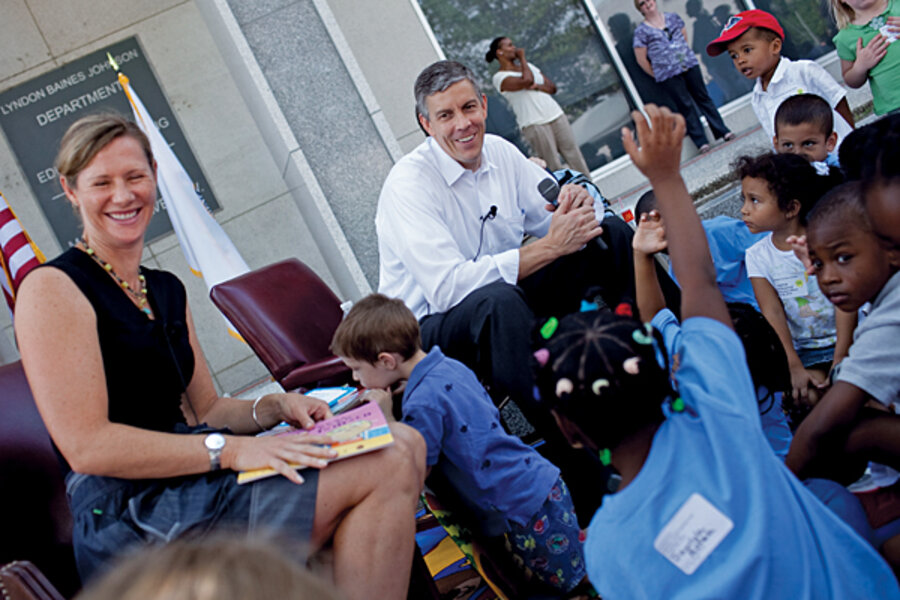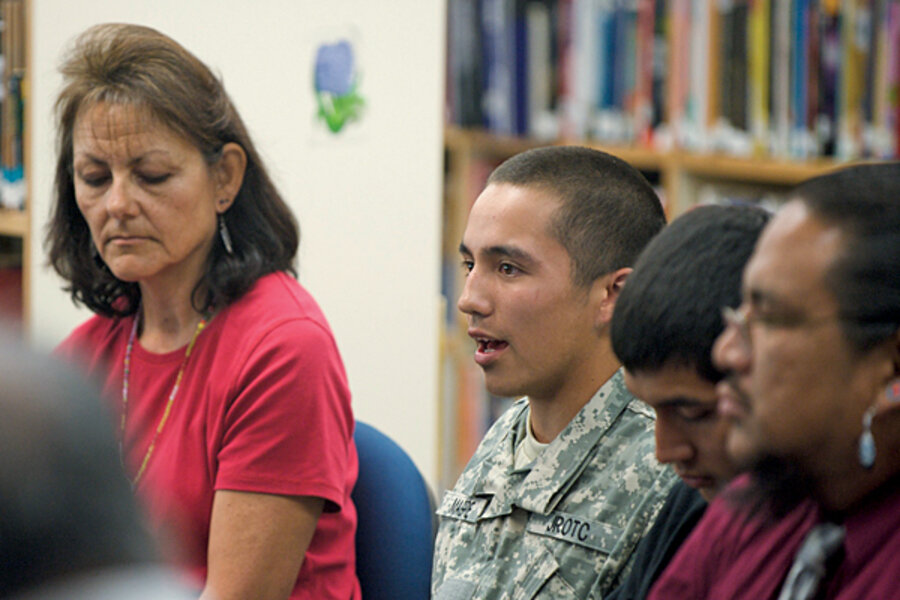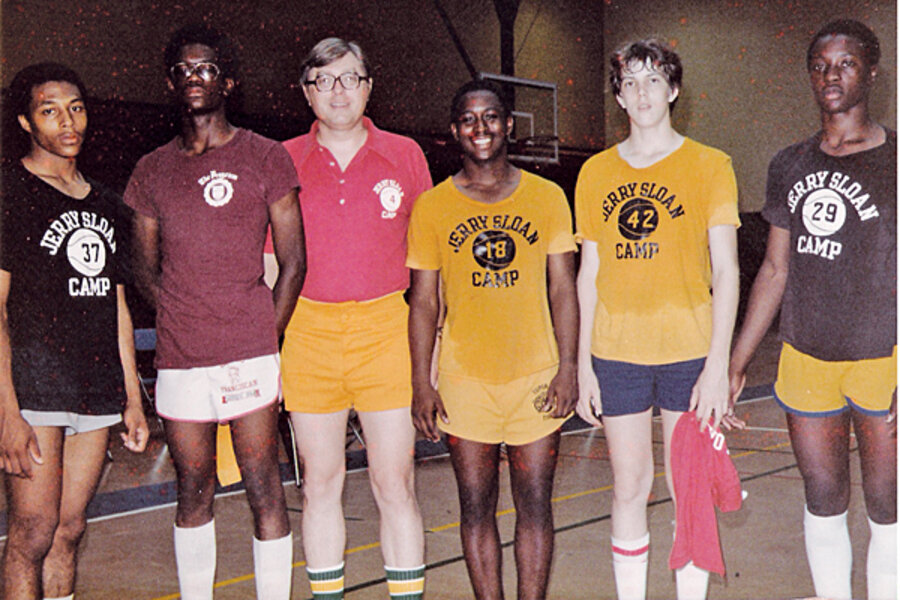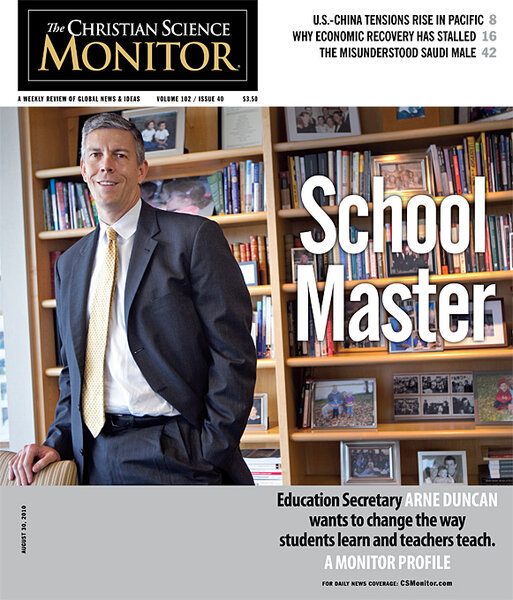Education secretary Arne Duncan: headmaster of US school reform
Loading...
| Chicago and Boston
Growing up in Chicago, Arne Duncan learned early that education was a stark dividing line – sometimes literally between life and death. At the South Side after-school center that his mom founded, he knew kids who'd made it all the way to fourth grade unable to read. And on the asphalt playgrounds of that rough area, he shot hoops with boys who later died in gang warfare. Mr. Duncan thought he'd glimpsed the worst kind of circumstance that can swallow up young people.
But then, on the desolate plains of the Northern Cheyenne Reservation in Montana, the secretary of Education met Lame Deer High School freshman Teton Magpie. And that, as Duncan recounts with a surge of emotion, was a vivid glimpse at an even lower rung of despair in the American education system.
Sitting in a circle with students and teachers and, in the native American tradition, passing a feather to the person who had the floor, Duncan listened to the usual litany of requests for computers and fancy equipment. But an air of defeatism pervaded the place: In the past six years, only eight students have gone on to four-year colleges. Duncan was incredulous.
And then Teton spoke. More than anything, he said, he just needed challenging classes and mentors so he could be the first in his family to go to college.
Duncan says he was hit by how mentally crushing it is to grow up surrounded by poverty – 70 percent of the reservation's adults are unemployed – and a sense that even school, the one place that might afford the opportunity to climb out of it, was letting kids down.
"Sometimes we need someone to come in and give us a little hope, because hope dies," Teton says now, recalling that day in 2009 when he met Duncan and how the secretary has kept in touch to encourage him.
Multiply moments like those with Teton, and add Duncan's own unusual background that took him from the inner city to Harvard to pro basketball, and you begin to understand the force of his determination to be a changemaker.
As the 2010-11 school year opens, educators nationwide are implementing controversial reforms wrought by Duncan. Students at some of the nation's worst schools will be coming back to a whole new way of doing business. And many schools will be focused even more systematically on accountability, showing that their students are gaining ground academically – with more teachers finding that their jobs depend on it.
Momentum for reform has been building for years and seems to be achieving critical mass with Duncan's market-based approaches.
Perhaps most empowering for Duncan is the unprecedented money he has been able to dangle as incentive. One of his first jobs as Education secretary was to distribute $100 billion of economic stimulus money. President Obama wanted him to invest part of that in promising reforms, which gave rise to Race to the Top, a competition in which a select few states will win a share of $4.3 billion.
The money represents less than 1 percent of annual federal, state, and local education spending, but the leverage for an Education secretary is unprecedented. Dozens of states have fallen into line with reform criteria – such as lifting caps on charter schools and tying teacher evaluations to student achievement – to improve their chances of winning.
"He's the most influential secretary that we've had since the Department [of Education] was created in 1980," says Charles Barone, federal policy director of Democrats for Education Reform in New York and a Democratic congressional staffer when the No Child Left Behind law was crafted during George W. Bush's presidency.
Indeed, says Chester Finn, who was an assistant secretary of Education under President Reagan and a K-12 expert at the conservative Hoover Institution in Stanford, Calif., Duncan has rendered the Republicans "speechless" – and cooperative – because "there's nothing they want to argue with him about."
Ultimately, proponents from all across the political spectrum say, Duncan could help dramatically narrow achievement gaps and even bring the United States back to high standing internationally. Or, as critics such as the irked teachers' unions see it, he'll further devastate an already demoralized teaching profession and subject children to more of the high-stakes testing that's been sucking the soul out of American schools.
• • •
To see where the idealism motivating Duncan comes from, picture what he recalls as the "Berlin wall" of Chicago's 47th street – the dividing line between the gang violence and poverty of the South Side and the middle-class oasis of Hyde Park in the shadow of the University of Chicago.
Then, listen to Chicago educator Ron Raglin's recollection of peeking out his South Side apartment window as a child and spying the Duncan family's blue van crossing that line, mother Sue Duncan at the wheel, violating all urban conventional wisdom: "Here's this white lady and her three small children – that was like, 'Wow!' "
It was so peculiar that Mrs. Duncan was often stopped by police wondering if she was lost. She wasn't: She was on her daily route to the afterschool center that she founded in the Kenwood neighborhood in 1961 after discovering her 9-year-old Bible study students couldn't read. She was so dedicated to her cause that she took her three children with her, through a gang- and drug-addled area, every day from the time they were born.
Mr. Raglin, who went to the center as a child and now works for the Chicago Public Schools (CPS), remembers the initial distrust when Sue Duncan began the program, including rumors that she put razor blades in the apples she distributed every day. For him, her center was a lifeline. And, he adds, it was key to the secretary of Education's worldview: "Arne's deep reservoir, his sense of service, of helping the least among us, that's where it comes from."
The Sue Duncan Children's Center remains a pillar of the neighborhood as well as grounding for the whole Duncan family. Started in church basements and now housed in an elementary school, its walls are crowded with books and photos of alumni, including actor Michael Clarke Duncan (no relation) and Kerrie Holley, now an IBM fellow.
Sue Duncan, now in her 70s, still goes there daily. And Arne Duncan's brother, Owen, and his sister, Sarah, work in education. It's "the family business," jokes Owen, now the center's director.
As he grew up, Duncan had a razor-sharp view of inequality. During the school day, he had every opportunity imaginable at the elite Lab School, a private school affiliated with the University of Chicago in the Hyde Park neighborhood where he lived. In the afternoon, he was at the center with his mom, learning with and tutoring kids from Kenwood.
"I grew up with folks in mom's school who were smarter than me, more talented, harder working, and just didn't have the opportunities [I had]," Arne Duncan says.
In a neighborhood where everything else pointed to Duncan's differences, basketball became a point of connection. And it was one of the few arenas where the scrawny white teen, who soared to the height of 6 ft., 5 in. much later, didn't have an advantage. But he began wandering Chicago's South Side and the west in search of games, crossing gang territory and playing near crack houses.
"If you want to get better, you have to find the best people to play with," Duncan says during a recent trip to Chicago to play in a charity basketball tournament. "It was pretty simple for me."
But running with this tough crowd was intense. He was exposed to kids who had even fewer opportunities than those he met through his mom's program. He was friends with gang members he only knew by nickname – kids who would scare most people. "Little Dan," for example, would warn Duncan to be on his way when his radar for violence suggested trouble coming. Two other boys Duncan was close to were killed.
"When you're a young kid, that scars you," Duncan says. "It's very difficult to make sense of. What I figured out over time was that [for] the kids who stayed in [my mom's] program – there were these remarkable success stories. And the folks who didn't, the folks who dropped out on the streets, a lot of them ended up dead."
His friends from there say his actions were extraordinary, and earned him respect in African-American neighborhoods – just the community chops he'd need years later as he tried to reform failing schools as CEO of the Chicago Public Schools.
"He was an ambassador, ahead of his time," says Raglin.
• • •
The street smarts Duncan developed as a kid serve him well in the halls of power, say those who know him and like to illustrate his skills in basketball metaphors: He's humble enough to listen and collaborate on the assist, but he's got fierce instincts for when to drive to the basket.
Duncan's "cool, calm leadership style" first impressed Shaun Donovan when Duncan was co-captain of the Harvard basketball team. Mr. Donovan, now Obama's secretary of Housing and Urban Development, remembers a game when Duncan's play had students in the stands who'd never met before hugging in elation.
Duncan tends to pass rather than go for the glory himself, say friends. It's a humility that comes through off the court, whether he's reading to kids or attending a cabinet meeting, says Donovan, who plays with the secretary of Education and President Obama. He's heard both the president and Duncan credit the discipline and teamwork of the sport as a model for life and leadership – it teaches you, for one, that if you try to do something on your own, you'll fail.
"In Washington, people like to take credit.... [Duncan] is the opposite," wanting to shine a light on schools and people who are achieving great results, says Jon Schnur, the CEO and cofounder of the nonprofit New Leaders for New Schools and a onetime adviser to the Obama campaign and to Secretary Duncan.
"A lot of people bring different issues and options to him and talk about the politics of this or that," Mr. Schnur says, "and Arne says, 'I'm not a politician.... The question for me in every policy decision is, 'What's in the best interest of kids?' "
To answer that question, Duncan does a lot of listening – the lean-forward, sleeves-rolled-up, look-you-in-the-eye kind of listening that makes people on every side of a thorny issue feel respected.
During his first year as secretary, he visited educators, students, and parents in 23 states on a "listening and learning tour." On a single day this spring, he delivered a commencement address and then packed in two roundtable discussions – one with award-winning Boston public school teachers and another with a team of educators, administrators, and union officials in nearby Revere, Mass., who had overcome differences to create a new "innovation school" that embraces a host of reforms.
He spent just enough time talking to praise the groups for their efforts and tell them what he was there to learn. Then he sat listening, taking occasional notes in a white binder.
When he visits schools, he leaves a signed basketball. And when there's time, he squeezes in a pickup game with the kids, opening the door to a whole different level of conversation.
But paired with the listening, Duncan has a bold, decisive streak, a willingness to take a stand that even core constituencies might balk at.
John Rogers, a Chicago investment manager who has played in adult basketball tournaments with Duncan, likens that trait to the time Duncan, with blood gushing from a broken nose as the other team screamed at the referee to stop play, made the winning three-point shot.
"He's the guy you want to have the ball in his hands at the end of the game," says Mr. Rogers, whose friendship with Duncan started in their Lab School days. "He's going to take the big shot and not shy away from it. He's such a nice guy, people can underestimate ... that steel backbone that can be there to fight," he says.
Independent thinking runs in the family. Besides his mother's inner-city efforts, his late father, Starkey Duncan, was a psychology professor at the University of Chicago who tried to bring data-driven methodology to what some saw as a soft science. Owen says his brother combines his father's rational approach with the emotion that drove his mother.
Duncan took a year off from his sociology studies at Harvard to work at his mother's program and research his senior thesis on the aspirations and opportunities of the urban underclass. That year convinced him that rather than follow many of his classmates to Wall Street or to graduate school, he wanted to pursue a career in education.
But first he had to try his hand at basketball. After graduation in 1987, his tryout for the Boston Celtics flopped, so he went to Australia to play pro ball until 1991. He met his wife, Karen, there. They now live in Arlington, Va., where their daughter and son attend a public elementary school ("I'm totally just daddy there," Duncan insists.)
It was Duncan's independence – specifically, his willingness to take political risks – as CEO of the Chicago Public Schools, that prompted Democrats for Education Reform to campaign for him to fill Obama's cabinet post.
"To get the kind of transformational change that we as a country need takes a huge amount of courage," Duncan says in Boston as an SUV zips him to the airport. "The status quo isn't working for lots and lots of children in this country.... We have to get a lot better with a huge sense of urgency because the stakes are so high.... But the most courage is [shown by] those leaders who are doing the hard work every day in the classrooms and the schools."
• • •
Chicago is where Duncan first discovered the differences he could make in education with some power and the backing of the local administration.
It was his friend Rogers, the investment manager and philanthropist, who ultimately brought him back to the city from Australia, hiring him and his sister to work on a mentoring program he'd started through the Ariel Education Initiative, in which a sixth-grade class at Shakespeare Elementary was promised affordable college if they graduated from high school. Later, Duncan helped Rogers turn Shakespeare into the Ariel Community Academy, a small public school sponsored by Rogers's firm under a Chicago reform initiative.
After seven years working at Ariel, Duncan joined the CPS under CEO Paul Vallas, helping to run its magnet school program and becoming a deputy chief of staff. When Mayor Richard M. Daley appointed Duncan CEO of the low-income minority district in 2001, the decision was met with some skepticism, given Duncan's lack of a teaching background and the relatively low posts he had held in the district.
But Duncan went on to have a long tenure by urban superintendent standards, and quickly proved himself a reform-minded CEO, championing a number of the same measures that he now wants to scale up as Education secretary.
He pushed for the closure of Chicago's worst schools – often amid a great deal of controversy – and opened dozens of new schools, many of them charters. He pioneered the turnaround strategy, in many cases partnering with nonprofits that would replace the leadership and most of the teaching staff at some of the city's worst-performing schools. He was willing to try out new incentive programs for schools making improvements, including awarding them with a high degree of autonomy.
"The longer he did the charter school thing, he realized that [autonomy] was what makes charter schools successful, and that all schools should have this," says Elizabeth Purvis, executive director of the Chicago International Charter Schools, the city's largest charter-school operator.
Ms. Purvis credits Duncan for working hard to bring all the players to the table even on the most contentious issues, and for communicating well to his staff and to the many players outside the CPS. "Everybody understood his vision, his mission, and how he was going to get there," she says, noting that people rarely recognize how important that ability is in a superintendent until it's missing.
For Purvis, it meant she could tell potential funders how her charter school network fitted into the framework of the district. In the CPS, the 8,000 students in her schools are a "drop in the bucket," she says, "but [Duncan] always made me and my organization feel valued."
If there was a major weakness, says Purvis, it was that he often under-estimated how much entrenched bureaucracy stood in the way of change. "He would just say to his team, 'Get it done,' and sometimes it was impossible to get it done," she says, recalling that it took five years for Duncan's team to get the federal funding her charter schools were entitled to.
Not all of Duncan's initiatives worked, and the jury is still out on how well many of the turnaround and new charter schools are performing. One study out of the Consortium of Chicago School Research showed that kids from schools he closed simply ended up in schools that were just as bad or worse. A study last year by the Civic Committee of the Commercial Club of Chicago concluded that some of the reported test-score gains among elementary students were due to changes in the tests. And the performance of high-schoolers refused to budge: Only 27 percent of 11th-graders met or exceeded standards on Illinois's achievement exam in 2008 – the same as in 2001.
But most agree that by some measures, education did improve under Duncan's tenure, including the sharp rise in elementary school students meeting or exceeding state math standards: from 35 percent to 71 percent between 2001 and 2008. High school graduation rose from 47 percent to 54 percent in the same period.
"I don't think [Duncan's tenure] is quite the miracle it looks like on paper, but a lot of good stuff happened," says Diane Whitmore Schanzenbach, a professor of education and social policy at Northwestern University who has studied the city's charter schools. "Some of the charter schools seem to be doing a good job and some are performing poorly, but they seem to be closing the ones that stink."
Duncan is particularly proud of the fact that between 2004 and 2008 the number of students taking Advanced Placement college-level tests more than doubled, and the percentage of CPS students enrolling in college went from 44 percent to 53 percent. He also began recruiting teachers from top education schools, and the city went from having two teacher applicants for every job to 10.
But Duncan's reform agenda – specifically the idea of tying teacher evaluations to students' standardized tests – has irked a core Democratic constituency: unions. A recent Los Angeles Times series that used student test scores to estimate the effectiveness of teachers in the Los Angeles Unified School District outraged unions so much that they called for a boycott of the newspaper. Little wonder that when Duncan talks about change, some teachers feel they've got targets on their backs.
That played out vividly in February when the principal and all the teachers at Rhode Island's Central Falls High School were told they'd be fired at year's end. With its graduation rate hovering around 50 percent, the high school in Rhode Island's poorest city had been pegged as one of the worst in the state.
After failing to reach agreement with the union on changes such as extending the workday to provide more academic support, the superintendent and state education commissioner agreed on the more drastic "turnaround" plan, one of four options pushed by the US Department of Education through Race to the Top and other grant competitions.
As the story made national headlines, both Obama and Duncan weighed in with support for the district plan. One of Duncan's priorities is dramatic improvement at the bottom 5 percent of the nation's schools. The mass firings at Central Falls showed "courage and doing the right things for kids," he said in a written press statement. "When schools continue to struggle we have a collective obligation to take action."
Teachers far beyond Central Falls felt betrayed.
"We have to be very careful in an environment like this not to give license to scapegoaters and demonizers [of teachers]," and Duncan's and Obama's comments gave that license, says Randi Weingarten, president of the 1.4 million-member American Federation of Teachers (AFT).
"This kind of [turnaround] strategy has been tried in education and has in the main failed," she says. "It creates a chilling effect against doing something we know is important: recruiting great teachers to go and to stay in hard-to-staff places."
From the perspective of Rhode Island Education Commissioner Deborah Gist, though, Duncan's statement indicated that he shared her unwillingness to "wait around for all of the adults to feel comfortable about the changes.... We needed to move forward."
Ultimately, the union and the superintendent in Central Falls came to an agreement in May that avoided mass firings – with teachers agreeing to longer school days, a new evaluation system, after-school tutoring, and other changes they had resisted. Commissioner Gist and Duncan supported that plan as well, but the resolution didn't make headlines the way the original teacher-firing plan did.
Despite the rifts over reform efforts, Duncan has managed to cultivate good working relationships with the national unions.
"He's very accessible," says Dennis Van Roekel, president of the 3.2 million-member National Education Association, who meets with Duncan about once a month. "During the Bush administration ... we didn't have any meetings with the Department of Education."
But teachers like Melanie Allen are wary. She was among those who met with Duncan at an elementary school in Boston's Chinatown this spring. When he asked what teachers most need, Ms. Allen said they need support to work as teams. Later, the middle-school English teacher told the Monitor that for all the good intentions of Duncan's reform agenda, she worries that when ideas like merit pay are implemented, they will backfire. "If competing, there's an incentive to keep best practices to yourself; it undercuts the important work schools need to do," she says.
Two Chicago teachers offer opposing views of Duncan's agenda.
"[With] all the privatization and testing, it seems like the Obama administration has bought into this side of [reform] as opposed to having any practical knowledge of what goes on in the classroom," says Lars Johannsen, an English teacher at Ariel Community Academy.
But Jesch Reyes, who taught at an elementary school serving mainly poor African-American kids during Duncan's tenure in Chicago, saw Duncan take teacher input seriously. "He wouldn't just say, 'That's a great idea....' He did his own due diligence, followed up," Mr. Reyes says. "[He] was quite knowledgeable about the kind of things that happen in a classroom."
While Duncan's advocacy of school turnarounds, merit pay plans, and charter schools has frustrated many teachers, it has also earned him plaudits from others. And his popularity among reform-minded Democratic and Republican politicians sometimes makes for strange bedfellows. Former House Speaker Newt Gingrich has shared the stage with Duncan and civil rights advocate Al Sharpton, for instance, in promoting such reforms.
"I think he's a moderate-to-liberal Democrat, but I think he's courageous, sincerely committed to reform, puts children first," observes Mr. Gingrich. "And to have someone in his position willing to take on the teachers' unions is very significant."
Rep. John Kline of Minnesota, the top Republican on the House Education and Labor Committee, credits Duncan for his unusual level of "willingness to reach across the partisan aisle," including direct meetings between the two as the committee has been considering how to revise the massive federal education law known as No Child Left Behind, an undertaking that will require bipartisan collaboration.
The leverage Duncan is exercising doesn't sit well with everyone. "Washington doesn't know how to remedy schools, and you should forgive me, but neither does Arne Duncan," says education historian Diane Ravitch, a onetime supporter of No Child Left Behind who now thinks it's had a corrosive effect. Race to the Top, in particular, is an aggressive intrusion of federal power, says Mrs. Ravitch, an assistant secretary of Education during the presidency of George H.W. Bush.
• • •
Whether or not the reforms are the right ones, Race to the Top and other grant competitions have catalyzed them faster and more broadly than anyone expected.
At least 13 states have changed laws to allow more charter schools. The six states that prohibited evaluating teachers based on student achievement have all dropped those restrictions, and at least 11 states now require such linkage. And 35 states plus the District of Columbia have adopted the voluntary Common Core Standards designed to make high school graduates college- and career-ready – the closest this country has ever gotten to national education standards.
With so many states cash-strapped by the recession, some educators and civil rights groups have criticized the competitive approach to funding, saying all districts need the money.
Obama and Duncan won back some good-will from states this summer when, after the two stumped to save teachers' jobs, Congress sent an additional $10 billion to states for that purpose.
Duncan defends the competitive approach for a small share of federal education dollars, saying it's not a top-down dictate but a way to reward innovations. Most federal funds are still distributed to all states based on longstanding formulas.
"When all you do is formula [funding], you just feed the status quo," he says. "If you give people a chance to put their best foot forward ... we're going to have more and more proof points around the country of the extraordinary difference people make in students' lives, and I think it's going to change the national conversation."
Duncan is not about to squander a "once in a lifetime opportunity" for education reform. "I know what's possible," he says, recalling friends from Chicago who grew up in poverty and went on to do remarkable things. "This isn't theory for me.... No one can tell me what kids can't do."










